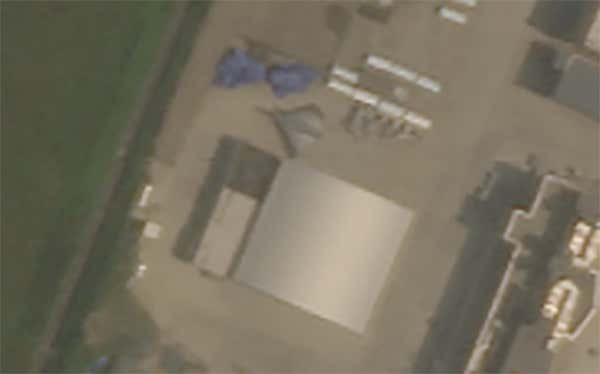Satellite images reveal unusual airframe resembling ‘tailless’ fighter design at Chinese test airfield
Satellite images have revealed a “very unusual” fighter jet at a Chinese airfield, as concerns grow about Beijing’s rapid military advances.November 1, 2021 - 11:40AM
A strange aircraft resembling an abandoned “tailless” fighter jet concept has been spotted in China.
Defence website The War Zone made the discovery while analysing satellite images of the test airfield at Chengdu Aerospace Corporation, one of the country’s pre-eminent fighter jet manufacturers, noting that the “puzzling airframe” seemed to have appeared some time in the first half of this year.
“It appears to be a large modified diamond-like delta platform with a relatively thin nose section,” wrote The War Zone editor-in-chief Tyler Rogoway, adding it appeared to have a similar wingspan to the J-20 fighter jet.
Rogoway said the “very unusual airframe” immediately reminded him of two-decade-old concept art for the X-44 Manta – or Multi-Axis No-Tail Aircraft – a joint project between the US Air Force and NASA that was cancelled in the year 2000.
The strange airframe was spotted next to a hangar at Chengdu airfield. Picture: Planet Labs
The biggest advantage of tailless designs is greater stealth capability due to reduced radar signature. They also offer greater fuel efficiency and weapons carrying capacity.
The biggest disadvantage is the increased difficulty achieving stability without vertical tails, and the reduced manoeuvrability.
The X-44 Manta design would have compensated for this using thrust vectoring – directed engine exhaust via nozzles, as seen in vertical takeoff and landing (VTOL) capable aircraft including the Harrier.
“Just the possibility of realising such a design is highly dependent on advanced fly-by-wire digital flight control technology and the software that underpins it,” Rogoway wrote.
“But really, such a design would be more about range, payload, speed, and low observability, not super manoeuvrability.”
Rogoway noted that such a platform, which could be an unmanned companion to a manned fighter like the J-20, “far better suits America’s potential threat realities and operational hurdles than short-ranged fighters” that “trade critical performance capabilities for less relevant manoeuvrability”.
The US Air Force has unveiled similar tailless concepts as part of its Next Generation Air Dominance (NGAD) program, which is expected to produce a new sixth-generation fighter jet to replace the F-22 Raptor, among other designs.
Lieutenant General Clinton Hinote, the Air Force’s Deputy Chief of Staff for Strategy, Integration and Requirements, told Air Force Magazine earlier this year that the F-22 would begin to phase out in about 2030.
He said the NGAD fighter would be needed soon to defeat a Chinese stealth aircraft and missile threat that is “closer than we think”.
“The time is absolutely coming where the combination of something like a [Chinese] J-20 with an advanced … missile is a threat to air superiority for the United States,” he said. “It’s something we’ve got to address.”
It comes amid growing concern about Beijing’s rapid advancements in military technology, particularly hypersonic missiles.
General Mark Milley, Chairman of the Joint Chiefs of Staff, last week described reported tests by China earlier this year of an orbital hypersonic missile system as close to a “Sputnik moment”.
“What we saw was a very significant event of a test of a hypersonic weapons system, and it is very concerning,” Mr Milley told Bloomberg TV.
“I think I saw in some of the newspapers, they used the term ‘Sputnik moment’. I don’t know if it’s quite a Sputnik moment, but I think it’s very close to that. So it’s a very significant technological event that occurred, or test that occurred, by the Chinese, and it has all of our attention.”
But Mr Milley cautioned that China’s hypersonic test was “just one weapon system”.
“The Chinese military capabilities are much greater than that,” he said.
“They’re expanding rapidly in space, in cyber, and in the traditional domains of land, sea and air … We’re seeing the rise of a country that is unlike something we’ve seen probably ever before.”
Over the weekend, China’s new stealth fighter jet – a carrier version of the Shenyang FC-31 – was spotted in the air for the first time.
It’s the first carrier-capable fighter to be developed outside the US, and is expected to play a vital role in the People Liberation Army Navy’s carrier force development.
Meanwhile, China is preparing to show off another aircraft out of Chengdu Aerospace Corporation, with reports the world’s first twin-seater stealth fighter could make its maiden flight in less than a fortnight.
The South China Morning Post reported last week that pictures and video clips had emerged on Chinese social media of the fighter, a variant of the J-20 Weilong, taxiing on a runway at the airfield in the southwestern province of Sichuan.
China is also expected to soon unveil its next-generation, nuclear-capable stealth bomber, the H-20, which experts say will likely be able to fly up to 5000km without needing to refuel.
‘Very unusual’ Chinese fighter jet spotted
A strange aircraft resembling an abandoned “tailless” fighter jet concept has been spotted in China.




